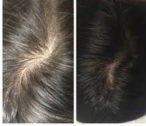PRP Hair Restoration
A novel new use of PRP is for treatment of thinning hair. The demand for this is growing rapidly and, as there are so few effective treatments for hair loss, this has been a boon to many who suffer with thinning hair.
PRP is the only non-invasive procedure available at this time for hair loss. Before PRP, surgical hair transplantation was the only available treatment option for those suffering from hair loss. Hair transplantation is a process which removes hair follicles from the back of the scalp and transplants them to areas of hair loss. PRP injections are a holistic, non-invasive treatment for hair growth and regrowth.
The ideal PRP candidates are patients, male and female, experiencing excessive shedding. Patients with hair loss who have their hair follicles intact are good candidates. And while it can combat early signs of male or female pattern baldness, patients with excessive balding are not ideal PRP candidates. There are few contraindications for PRP and it is safe for the vast majority of patients.
The concentrated growth factors found in PRP stimulate cell renewal and increase blood flow thereby encouraging a new active growth phase for dormant hair follicles. The proteins and cytokines of PRP both play an important role in stimulating the hair follicles to generate hair growth. A series of PRP treatments makes possible fuller, more robust, healthier hair.
Treatment is rendered in two parts: painless blood draw and re-injection of concentrated PRP into the anesthetized scalp.
PRP hair treatments take approximately one hour and a series of three to four treatments spaced 4 – 6 weeks apart are required. Hair grows about 1 cm a month and although growth is continually evaluated, results are best judged after six months. Typically, maintenance injections are recommended every 6 months.
After treatment, most patients can return to their regular activities. Side effects can include tenderness, swelling, bleeding, bruising, itching, and even tiny scabs in the treated area. Some experience mild headaches which can be relieved with Tylenol. However, most patients report no problems and tolerate their procedure easily.
The final results are visible at 6-12 months. The results of PRP treatments can be maintained by taking oral prescription medications such as Finasteride (Propecia) or Spironolactone. In addition, taking over-the-counter vitamins such as Viviscal and Nutrafol have been shown to be helpful. Topical Minoxidil (Rogaine) used daily, and the Laser Cap used three days a week will also promote and maintain hair growth. Treatment results may not be permanent as hair loss is triggered by varied factors, and the source of your unique hair loss may not respond long-term to the PRP procedure. Hence the reason for maintenance treatments.

After PRP Treatments
